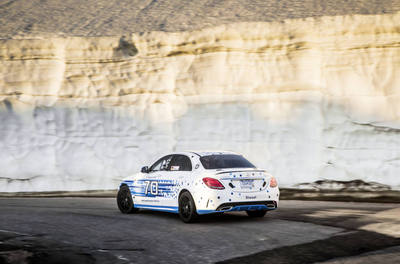New Record for Series-Production Diesel Car in US Hill-Climb Race: Mercedes-Benz C 300 d 4MATIC Sets New Record at Pikes Peak
 |
EDITOR'S NOTE : The 2016 Mercedes-Benz C300d 4MATIC Sedan will go on sale in the U.S. at the end of the first quarter of 2016.
STUTTGART/COLORADO SPRINGS, CO June 30, 2015: Mercedes-Benz has set a new record for the diesels in the legendary Pikes Peak hill-climb race with a near-production C 300 d 4MATIC: Test driver Uwe Nittel completed the 19.99 km long route which includes more than150 bends at a range in altitude of nearly 1400 metres in just 11.37 minutes.
"With extensive
simulation measures, gruelling durability road tests and exhaustive trial
driving at test sites all over the world, Mercedes-Benz's testing programme
is undoubtedly one of the most rigorous in the automotive branch," says
Prof. Dr Thomas Weber, member of the board of management of Daimler AG,
responsible for Group Research and Mercedes-Benz Cars Development. "Pikes
Peak raised the crossbar still further. And the virtually
series-productionC 300 d 4MATIC demonstrated in this test that sporty
performance and clean exhaust technology go together perfectly."
The test drive at Pikes Peak also demonstrated how well
Mercedes-Benz diesel powertrains are adapted to the special requirements of
the US market, which include extreme climatic conditions.
The course’s numerous switchbacks put the suspension
and the 4MATIC powertrain through their paces when accelerating out of the
bends. Another challenge for the diesel engine was the thin mountain air
– the finishing point is an impressive 4301 metres above sea level.
Test driver Uwe Nittel, 46, reports: "Shoving a series diesel saloon with
automatic transmission up Pikes Peak sounds like a crazy idea, put it was a
lot of fun. And it showed that all the prejudices regarding diesel vehicles
are well out of time."
Nittel comes from
rallying: numerous victories in national championships and the rally world
championship culminated in the vice world champion's title in group N
(1996). In 2011 he belonged to the team that won the FIA truck racing
European championship.
The 150
kW (204 hp) C 300 d 4MATIC (in Europe known as 250 d) fitted with
a 7G-TRONIC PLUS automatic transmission competed in the hill-climb race in
largely series-production configuration. As is customary for a racing car,
the interior was cleared out. The modifications included the safety
measures required by the regulations, such as a roll-over cage, racing
tank, fire extinguishing system, enhanced brakes and ultra-high-performance
tyres (UHP).
The environment-friendly engine
technology remained completely unchanged. Thanks to the highly effective
emission control system, the C 300 d is the first diesel model to undercut
the American ULEV 70 emissions limits, which are among the strictest in the
world. With a combined range of 34 miles to the gallon (corresponding to
4.1 litres of diesel per 100 kilometres), the C 300 d attains a level of
fuel efficiency which is superior to that of most hybrid vehicles on the
US market. In inter-urban traffic the vehicle runs on 42 mpg (FE
Highway).
The engine technology: clean
and economical
The C 300 d is powered
by a four-cylinder diesel engine with fourth-generation common rail direct
injection featuring piezo injectors, two-stage turbocharging and exhaust
gas recirculation. A highly sensitive engine control system responds
precisely to the most diverse operating conditions, thereby optimising the
combustion processes. The emission control system incorporates a
close-coupled electrically heated oxidation catalytic converter and a
diesel particulate filter which is located in the area of the bulkhead.
This shortens the regeneration times.
The core
of the emission control system takes the form of an SCR (Selective
Catalytic Reduction) catalytic converter, with an "AdBlue®"
injector connected upstream. "AdBlue®" is a synthetic aqueous
urea solution which causes the nitrogen oxides (NOx) to be reduced to
harmless nitrogen in the SCR catalytic converters. Monitoring and diagnosis
of the complex exhaust gas aftertreatment processes are performed by
various sensors, including a differential pressure sensor, a lambda sensor,
NOx and temperature sensors.
The
hill-climb race: legendary and gruelling
156 bends and a difference in altitude of 1439 metres over
a distance of just under 20 kilometres – the "Broadmoor Pikes Peak
International Hill Climb" (PPIHC) in the US state of Colorado is arguably
the most spectacular and demanding hill-climb race in the world. The uphill
gradient averages seven percent. The epithet "Race to the clouds" derives
from the alpine topography: The race begins at an ample altitude of 2862
metres, and the finishing point at the summit of Pikes Peak in the Rocky
Mountains is no less than 4301 metres above sea level. The entire route has
been asphalted since 2011.
PPIHC is one of the
very oldest motorsport events:Races for automobiles and motorcycles have
been held here since 1916, and this year's event was the 93rd in the
course's history. The best-known winners include the American Bobby Unser,
who won the hill-climb race 13 times in all, Indycar drivers Mario Andretti
(1969) and Rick Mears (1976) and rally drivers Michèle Mouton (1984, 1985),
Walter Röhrl (1987), Ari Vatanen (1988) and Sebastien Loeb
(2013).


